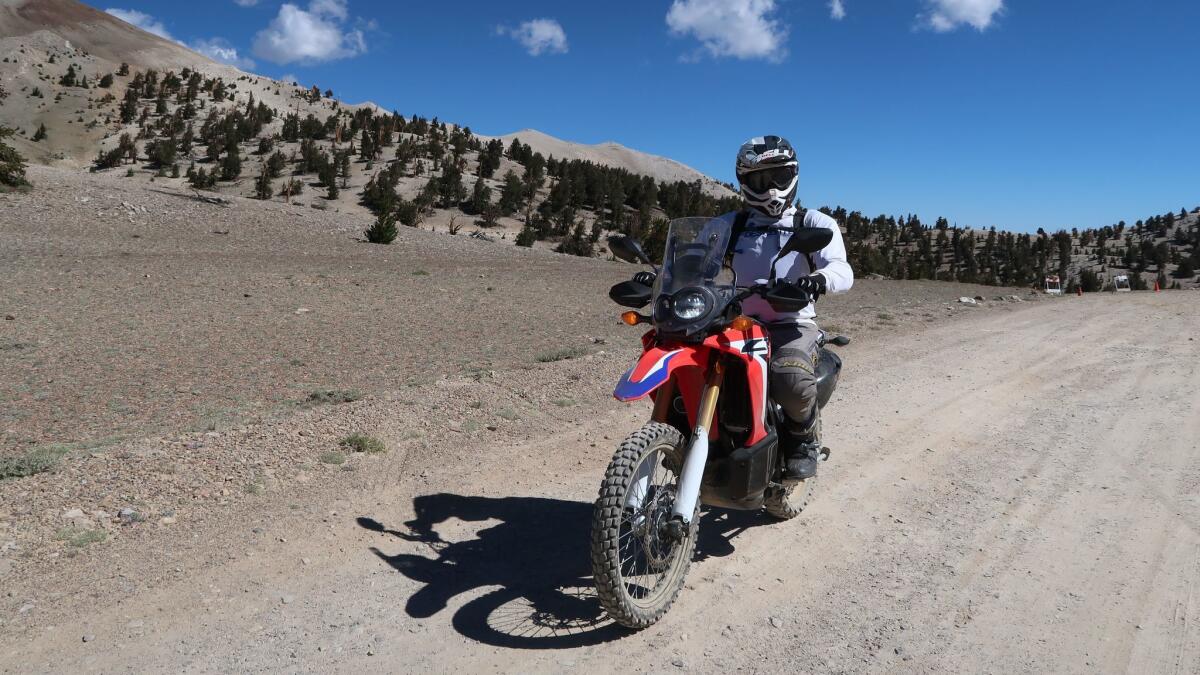Honda’s CRF250 Rally: Bigger, better than it looks
The last couple of years have seen interesting developments in the “adventure riding” motorcycle segment. It's the fastest-growing niche and seems to be attracting increasing numbers of older riders.
But both beginners and older riders may have issues with the size, weight and power of the class-leading adventure bikes, which often have 1000cc or 1200cc engines, weigh more than 500 pounds, and sit very high. They include
To attract those riders, manufacturers have been busy building smaller-bore adventure bikes, and dual-purpose bikes, that can perform adequately on-road and off.
A few weekends back, I borrowed Honda’s new CRF250L Rally, and gave it a test run that included high-speed highways, twisty mountain roads, dirt roads, rock-strewn jeep trails, and altitudes above 12,000 feet in elevation.
A bigger, better L
Honda’s CRF250L is an entry-level dual-purpose motorcycle that, when first introduced, didn’t impress me much during my 2013 review ride. While the bike performed well around town and was steady on the freeway, it didn’t have the horsepower, suspension or travel to handle much rough stuff.
So I was pleased when Honda introduced the Rally version late last year.
Not everyone shared my enthusiasm. Some of my colleagues derided the CRF250L Rally as nothing more than CRF250L in Africa Twin livery — the same bike, pretending to be related to Honda’s Dakar Rally machines.
That wasn’t fair, and turned out to be not quite true. The Rally, while still tame by Dakar standards, included some upgrades that gave it considerably more off-road capability.

How the two bikes compare
The Rally is more than just a dressed-up version of the 250L. In addition to more powerful front brakes, a windscreen, blacked-out wheels and that “Rally-style” color scheme, there are several areas in which the Rally is a more capable bike than the 250L — off-road and on.
CRF250L Rally
- Horsepower: 24.5
- 341.7 pounds curb weight
- 2.6-gallon gas tank
- 35.2" seat height
- 10.7” ground clearance
- 11”/10.3” travel, front/rear
- Windscreen standard
- $5,849 MSRP
- ABS optional for $300 extra
Although sharing the 250L liquid-cooled engine, six-speed gearbox and chassis and strapped with the same 18" rear and 21” front wheels, the Rally version stands taller, has more ground clearance, and has more suspension travel than its little brother bike.
All of that came in very handy on my recent test run.
With a friend riding another new small-bore adventure machine — the Kawasaki Versys 300 — I tackled a backcountry patch of pavement unofficially known as California’s “highest motorable road.”
Peeling off of California 168, east of Bishop, paved White Mountain Road climbs from 4,000 feet to about 10,000 feet before becoming a dirt road. Then, over a washboarded but otherwise well-maintained 14 miles, the road climbs to 12,470 feet before it stops at the White Mountain Research Center at Barcroft Station.
I didn’t expect a lot from the little bike. At 6 feet and 175 pounds, I’m perhaps a little big for a street-tuned 250cc motorcycle. I especially didn’t expect the Rally to perform well at high speeds or high altitudes.
But I was pleasantly surprised. At 65 miles per hour, on US 395, the Rally had enough power to keep up with traffic and offered enough wind protection for me to stay unbuffetted and comfortable.
Climbing White Mountain Road, there were plenty of times when I wished for more power, and plenty of times when I had to drop a gear to maintain pace. But even above 10,000 feet, the Rally was still chugging along, carrying me ever upward into the thinner air.

Coming down from Barcroft Station, my companion and I elected to try Silver Canyon Road, recommended as a more rugged route than the way we’d come up.
And rugged it was — steep, rutted, rocky and washed out in sections by winter weather, it asked a lot of the little Rally.
Though I'd missed it on the street, I was glad now that the model I’d borrowed did not have the optional ABS — a lifesaver on paved roads, but troublesome in the dirt.
I also made good use of the 21-inch front wheel, off-road tires, 11 inches of front end suspension travel, and excellent front brake. These got me nimbly through the nasty sections and got me off the high mountain without too much drama.
At $5,849 (with an additional $300 for optional ABS) the Honda Rally is competitively priced. Surveying the crop of similar bikes at similar MSRPs, it’s hard to identify a better deal for this kind of motorcycle.
That’s partly because there aren’t many motorcycles quite like this. The aforementioned Versys 300 is really more a street than trail bike. The same can be said of the 300cc version of the Suzuki V-Strom, while Suzuki’s DR-Z400, more capable in the dirt, is less friendly on the street.
The Yamaha WR250R has many admirers but costs $1,500 more than the Rally. The extremely able small-size dual sport bikes made by KTM cost more than twice as much. The promised 310cc BMW 310GS, priced to move at $5,000, isn’t here yet. Neither is KTM’s rumored 390cc Adventure bike — though that will likely cost quite a bit more.
The only element that makes me hesitate to fully recommend the Rally is that engine. At 24.5 horsepower, pulling 341.7 pounds (when fueled) and a lot more when you add a rider, the engine just doesn’t have enough grunt.
On the other hand, that anemic powerplant does get a reported 94 miles per gallon in fuel consumption. I did the entire White Mountain loop on less than half a tank of gas.
If you’re not interested in aggressive trail riding and aren’t planning to rip up any sandy hill climbs, the Rally ably answers a lot of motorcycling needs.




